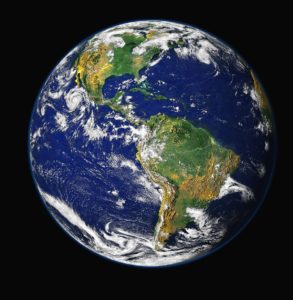 Just read about an international study that discussed how millions of bacteria and viruses circle the earth in the earth's atmosphere every day, and get deposited on land by rain and dust particles. Which could explain why similar viruses and bacteria are found in totally different environments in different parts of the world. The study measured what was deposited high in the mountains of the Sierra Nevada, but one would expect microbes to be deposited everywhere, not just in high mountains. We are surrounded by microbes! (Another post on this topic.) From Astrobiology:
Just read about an international study that discussed how millions of bacteria and viruses circle the earth in the earth's atmosphere every day, and get deposited on land by rain and dust particles. Which could explain why similar viruses and bacteria are found in totally different environments in different parts of the world. The study measured what was deposited high in the mountains of the Sierra Nevada, but one would expect microbes to be deposited everywhere, not just in high mountains. We are surrounded by microbes! (Another post on this topic.) From Astrobiology:
Most Viruses And Bacteria Fall From The Sky
An international research project led by the University of Granada has revealed for the first time that almost one billion viruses and more than twenty million bacteria circulate in the Earth's atmosphere and are deposited in high-mountain places every day. The research findings, published recently in the ISME Journal: Multidisciplinary Journal of Microbial Ecology (part of the Nature group) help to explain why genetically identical viruses have been found in such distant locations and diverse environments of the planet. The University of British Columbia (Canada) and San Diego State University (United States) also participated in the project.
The mechanisms responsible for the dispersal of these microorganisms at the global scale are still practically unknown. However, this pioneering project marks the first time that researchers have quantified the amount of viruses and bacteria deposited in the high mountains of Sierra Nevada after travelling thousands of kilometres in the Earth's atmosphere. The research team was also able to determine that these viruses and bacteria are primarily transported from the Atlantic Ocean and the Sahara Desert.
Every day almost one billion viruses and more than 20 million bacteria are deposited on each square metre above the atmospheric boundary layer (above 2500-3000 metres) in the Sierra Nevada mountain range. Interestingly, the deposition rates of viruses were found to be between 9 and 461 times higher than those of bacteria. Viruses and bacteria are normally deposited by means of atmospheric rain washout and gravity sedimentation. However, rain seems to be less efficient in the removal of viruses from the atmosphere than in the removal of bacteria. This seems to be related to the size of the particles to which viruses and bacteria respectively tend to adhere.
The main author of the paper, Dr. Isabel Reche, a Lecturer at the Department of Ecology (UGR), explains that: "We have discovered that most of the viruses are of marine origin and are usually transported attached to organic particles, which are smaller than the particles to which bacteria adhere." Bacteria, meanwhile, tend to stick to mineral particles, especially those from the Sahara Desert. In short, bacteria and viruses, generally speaking, are deposited through rain events and dust intrusions.
